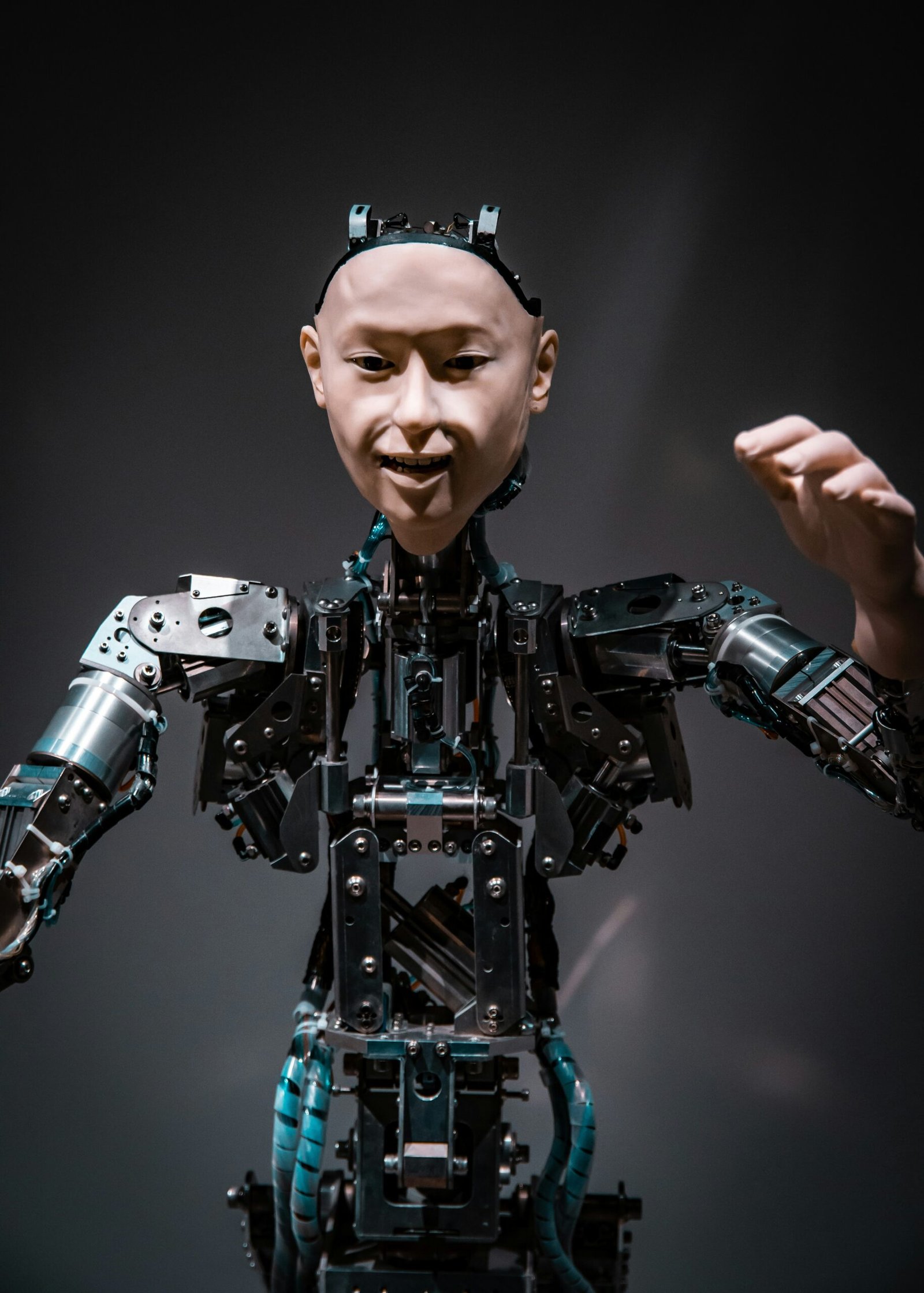What is AI?
Artificial Intelligence (AI) is a branch of computer science focused on creating systems that can perform tasks that typically require human intelligence. These tasks include learning, reasoning, problem-solving, perception, and understanding natural language. AI systems are designed to mimic cognitive functions associated with human minds, enabling them to analyze data, recognize patterns, and make decisions. This capability is crucial in various sectors, ranging from healthcare to finance, where rapid decision-making is essential.
At its core, Artificial Intelligence encompasses a variety of techniques and methodologies that allow machines to execute functions typically governed by human cognitive abilities. This includes machine learning, where systems learn from data over time and improve their performance without explicit programming. Another significant component is natural language processing (NLP), which enables machines to interpret and generate human language, making interactions more intuitive and user-friendly.
The significance of understanding Artificial Intelligence in the modern technological landscape cannot be overstated. With the rapid developments in AI, businesses are increasingly leveraging this technology to streamline operations, enhance customer experiences, and innovate products and services. By automating mundane tasks, AI allows human workers to focus more on strategic and creative endeavors. Moreover, AI systems can analyze vast amounts of data far more quickly than humans, uncovering insights that can lead to more informed decision-making.
As AI continues to evolve, its role in society raises important ethical and practical considerations. Issues such as data privacy, algorithmic bias, and the implications of AI on employment are at the forefront of conversations among technologists, ethicists, and policymakers. Understanding AI and its capabilities is essential for navigating these complexities and harnessing its potential for societal benefit.
How Does AI Work?
Artificial Intelligence (AI) systems operate through a combination of data processing, algorithms, and pattern recognition. At the core of AI is the requirement for large datasets, which serve as the foundational input from which the system learns. These datasets may include various forms such as text, images, or structured numerical data, enabling the AI to identify and understand different features within the data.
One of the primary mechanisms through which AI operates is via algorithms, which are a set of rules or instructions designed to solve specific problems. These algorithms analyze the data, searching for patterns and correlations that facilitate decision-making. Machine learning, a subset of AI, prominently utilizes statistical models that refine their predictions as more data is encountered. This process often involves training the model on a dataset, allowing it to adjust and improve its accuracy over time.
The training phase is crucial for the performance of AI systems, where the model is exposed to data and tasked with making predictions or classifications. During this phase, the system iteratively learns from errors and adjusts its parameters to minimize inaccuracies in its predictions. This iterative process is essential, as it ensures that the AI continues to evolve and perform better as it processes new data.
Moreover, AI systems rely heavily on feedback mechanisms. When the AI’s predictions are compared against actual outcomes, it receives feedback that informs further adjustments. This ongoing learning cycle, characterized by continuous improvement, is what distinguishes advanced AI from traditional programming methods. By integrating large datasets, employing sophisticated algorithms, and utilizing statistical models, AI can simulate human-like cognition and decision-making capabilities, effectively responding to complex challenges in diverse fields.
Common Applications of AI
Artificial Intelligence (AI) has permeated various dimensions of everyday life, facilitating numerous functions that enhance convenience and efficiency. One prominent application of AI is found in virtual assistants such as Siri and Alexa. These voice-activated assistants utilize natural language processing (NLP) to interpret user commands, manage various tasks, and provide information. Through continual learning, such systems adapt to individual user behaviors, improving their responses and functions over time.
Another significant area where AI plays a vital role is in recommendation systems. Services like Netflix and Amazon employ sophisticated algorithms to analyze user preferences and behaviors, suggesting content or products that align with individual interests. By harnessing AI, these platforms not only personalize the user experience but also drive engagement and sales, showcasing its effectiveness in consumer behavior analysis.
Moreover, the development of autonomous vehicles has highlighted the transformative capabilities of AI in transportation. Self-driving cars utilize machine learning, computer vision, and sensor data to navigate and understand their environment, aiming to enhance safety and efficiency on the roads. This advancement reflects the growing potential of AI to reshape industries and consumer experiences.
In the realm of healthcare, AI applications are proving to be revolutionary. AI technologies are now leveraged for diagnostics, where machine learning algorithms can analyze medical images and detect anomalies with remarkable accuracy. This capability not only aids healthcare professionals in making timely decisions but also contributes to improved patient outcomes. By streamlining processes and enhancing diagnostic precision, AI is fundamentally changing the landscape of medical care.
The various applications of AI illustrate its versatility and the significant impact it has across different sectors. As AI technology continues to evolve, it is poised to introduce innovative solutions and enhance everyday experiences globally.
What is Machine Learning?
Machine Learning (ML), a critical subset of Artificial Intelligence (AI), revolves around the ability of systems to learn from data. Unlike traditional programming, where explicit instructions dictate the actions of a machine, machine learning empowers algorithms to identify patterns and make decisions with minimal human intervention. This shift allows for enhanced performance on specific tasks as systems adapt and improve through exposure to varying data sets.
At the core of machine learning is the concept of training models. A model in this context is a mathematical representation that captures the relationships within data. During the training phase, a model is exposed to a large compilation of data, often referred to as the training set. The model analyzes the input data and adjusts its parameters to minimize errors in its predictions or classifications. Through iterative processes, it refines its predictions over time, thus gaining proficiency in performing the particular task it was designed for.
The distinction between traditional programming and machine learning is particularly noteworthy. In conventional programming, a programmer writes code to solve a problem with clear, step-by-step instructions. On the other hand, machine learning relies on data-driven techniques without the need for specific instructions on every action. This paradigm enables the creation of systems that can handle complex problems, learning directly from the information provided, and adapting as new data emerges.
Machine learning encompasses various approaches, such as supervised learning, unsupervised learning, and reinforcement learning. Each method has unique characteristics suited for different applications, from voice recognition to recommendation systems. As machine learning continues to evolve, it remains a fundamental aspect of advancements in AI, shaping the future of technology across multiple sectors.
Difference Between AI and Machine Learning
Artificial Intelligence (AI) and Machine Learning (ML) are terms frequently used in discussions about technology and innovation. While they are often used interchangeably, it is essential to recognize that they embody distinct concepts. AI serves as an umbrella term that encompasses a broad spectrum of technologies designed to simulate human-like intelligence in machines. These technologies can perform tasks such as natural language processing, problem-solving, perception, and decision-making, mimicking cognitive functions traditionally associated with human beings.
On the other hand, Machine Learning is a particular subset of AI that concentrates on the ability of machines to learn from data and improve their performance over time without explicit programming. Through sophisticated algorithms, machine learning enables computers to identify patterns and make predictions based on historical data. In contrast to traditional programming methods, where rules are predefined by developers, machine learning automates the process of learning, allowing systems to adapt dynamically and evolve as more data becomes available.
The distinction between these two concepts highlights their differing focuses and functionalities. AI is concerned with creating intelligent behavior in machines, while machine learning is focused specifically on the learning process itself. For instance, a voice recognition system that utilizes machine learning to improve its accuracy is a specific application of AI technology. Conversely, a broader AI system could integrate multiple technologies, including machine learning, to enhance user experiences across various tasks.
Understanding the difference between AI and machine learning is crucial for individuals and organizations navigating the ever-evolving landscape of technology. Recognizing the specific roles these fields play can help leverage their unique capabilities effectively. Ultimately, while both AI and machine learning contribute significantly to advancements in automation and intelligence, they serve the broader goal of augmenting human capabilities through technological innovation.
Are AI and Robots the Same?
Artificial Intelligence (AI) and robots are often intertwined in discussions surrounding technology, yet they are distinct entities that serve different purposes. At its core, artificial intelligence refers to the simulation of human intelligence in machines, allowing them to perform tasks that typically require cognitive functions such as learning, reasoning, problem-solving, perception, and language understanding. The algorithms and data structures that comprise AI empower systems to analyze information and make decisions, thereby exhibiting intelligent behavior.
On the other hand, robots are physical machines designed to execute specific tasks, often taking on forms that may resemble human beings or animals. A robot may incorporate various degrees of AI, but not all robots possess artificial intelligence. For instance, simple robotic devices may operate based solely on pre-programmed instructions without any cognitive capabilities. In contrast, advanced robots that utilize AI can adapt their behaviors based on real-time data and enhance their functionality through learning algorithms.
To further elucidate, consider the example of a robotic vacuum cleaner. This device navigates around a space to clean surfaces, demonstrating robotic capabilities. If it utilizes AI, it can learn the layout of a house, avoid obstacles more effectively, and optimize its cleaning patterns over time. This confluence of robotics and AI highlights the potential for enhancing robotic efficiency. However, it is crucial to recognize that not all robots have AI capabilities, and not all AI applications are embodied in physical robots. Understanding the differences between AI and robots ultimately leads to a clearer perspective on their respective roles and contributions to various fields.
Can AI Replace Human Jobs?
The discussion surrounding artificial intelligence (AI) and its ability to replace human jobs has garnered significant attention in recent years. As automation technologies continue to advance, the concern about job displacement grows. AI systems can effectively automate repetitive and routine tasks, leading to increased efficiency in various sectors such as manufacturing, data processing, and customer service. This automation has the potential to disrupt traditional job markets as roles that involve mundane tasks are increasingly performed by machines.
However, it is essential to recognize that while AI can replace specific job functions, it also has the potential to create new employment opportunities. As companies adopt AI technologies, they often require skilled professionals to manage, maintain, and improve these systems. This shift has led to the emergence of new job roles such as AI ethicists, machine learning engineers, and data scientists—positions that did not exist before the rise of AI. Furthermore, the integration of AI into various industries can enhance human capabilities, allowing workers to focus on more complex and creative tasks that require critical thinking and emotional intelligence.
Moreover, the relationship between AI and employment is not merely one of replacement but augmentation. By leveraging AI tools, employees can increase their productivity and efficiency. For instance, in healthcare, AI can analyze vast amounts of data to assist doctors in diagnosing conditions more accurately, thereby improving patient outcomes. In this sense, AI acts as a companion to human workers, streamlining processes without eliminating the need for human oversight and creativity.
In conclusion, while AI presents challenges to traditional job markets through automation, it simultaneously creates new opportunities for employment and enhances human capabilities. The dialogue on AI’s impact on jobs should therefore encompass both the potential for job displacement and the avenues for job creation, emphasizing the importance of adaptation in an evolving workforce landscape.
Is AI Safe?
As artificial intelligence (AI) becomes increasingly integrated into various sectors, concerns surrounding its safety have garnered attention. One of the primary issues is the ethical dilemmas associated with AI decision-making. In instances where AI systems are deployed to make critical decisions—such as in healthcare, law enforcement, or finance—there can be significant ramifications based on their outputs. These systems may operate based on data that contains biases, leading to outcomes that can perpetuate inequality or discrimination. The ethical implications of such biases necessitate rigorous scrutiny and a commitment to transparency in how these AI models function.
Moreover, the security vulnerabilities of AI systems pose a further concern. Like any technology, AI can be susceptible to attacks that exploit its weaknesses. For example, adversarial attacks can alter the input data to deceive AI models, causing them to produce erroneous or potentially harmful outputs. As reliance on AI increases, the importance of developing robust security measures to safeguard these systems cannot be overstated.
In response to these challenges, ongoing research efforts are directed toward creating safe and ethical AI. Scholars and practitioners alike are investigating methods to mitigate biases in AI algorithms through improved data representation and validation techniques. Additionally, frameworks are being developed to ensure that AI aligns with human values and operates under ethical guidelines that prioritize fairness, accountability, and transparency.
In conclusion, while the integration of AI into society presents many benefits, it also raises significant safety concerns that must be addressed. The path forward will require collaboration among researchers, policymakers, and industry leaders to ensure that AI systems not only function effectively but also uphold the ethical standards that foster public trust and safety.
Can AI Think or Feel?
The exploration of whether artificial intelligence (AI) can think or feel engages both the tech community and the general public. At present, AI systems are sophisticated tools designed to execute specific tasks by processing vast amounts of data through complex algorithms. Their operational framework relies on statistical correlations rather than any form of consciousness or genuine emotional engagement.
AI can mimic human-like responses and decision-making processes, which may create the illusion of understanding. For instance, chatbots and virtual assistants can respond to inquiries in a way that seems intelligent. However, it is essential to note that these responses are generated based on pre-existing data and programming. AI systems analyze patterns and leverage machine learning techniques to produce outputs that resemble human thought. Yet, this should not be mistaken for actual cognitive processing or emotional depth.
Current AI technology lacks genuine awareness or the subjective experience that comes with feelings. While they can simulate conversation or even provide empathetic-like responses, such behavior does not signify that they possess emotions or self-awareness. The algorithms at work are merely calculating the likelihood of various responses rather than experiencing feelings or thoughts similar to humans.
This distinction is crucial in understanding the limits of AI. As it stands, even the most advanced AI systems do not have the capacity to think or feel in the human sense. Their functionality is rooted in data manipulation, making them potent tools for problem-solving but devoid of any true consciousness. Recognizing this boundary helps clarify misconceptions about AI capabilities and reminds us of the fundamental differences between human intelligence and artificial constructs.
How is AI Trained?
Artificial Intelligence (AI) training involves several fundamental processes designed to enhance the model’s capabilities. At its core, training an AI model comprises providing it with extensive datasets that relate to specific tasks. These datasets are invaluable as they serve as the foundation for the model’s learning experiences. Different types of AI, including supervised learning, unsupervised learning, and reinforcement learning, utilize varying methods to acquire knowledge from these datasets.
In supervised learning, the AI model is fed labeled data, meaning that each input is paired with the correct output. This method allows the model to learn by example, as it identifies patterns and relationships within the data to make predictions. For instance, a supervised learning model designed for image recognition would process numerous images, each labeled with a corresponding classification, enabling it to learn how to categorize new images accurately.
Conversely, unsupervised learning utilizes unlabeled data. Here, the AI seeks to identify inherent structures or patterns within the dataset without explicit guidance. This approach is particularly effective for clustering and association tasks, where the model groups similar items together or identifies associations among variables without predefined labels.
Reinforcement learning is another training method, where the AI learns by interacting with its environment. In this scenario, the model makes decisions, receives feedback in the form of rewards or penalties, and uses this information to improve its future actions. This technique is commonly used in applications such as robotics and game-playing AI, where the model must continually adapt to changing circumstances.
Overall, the various training methodologies play a crucial role in equipping AI models with the ability to recognize patterns and make informed, data-driven decisions. Through iterative training and fine-tuning, the effectiveness and accuracy of AI can be significantly enhanced over time, ultimately resulting in systems that perform tasks efficiently and reliably.


